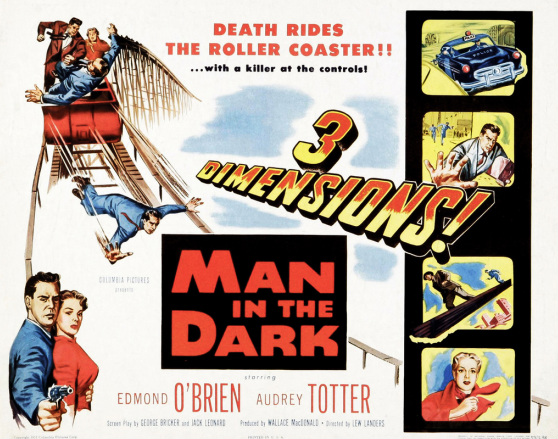Man in the Dark (1953)
After United Artist's Bwana Devil (1952) introduced 3-D to the Hollywood film industry with impressive box-office success, the race was on among major studios to produce another stereoscopic hit. Warner Brothers rushed through production of Andre de Toth's House of Wax (1953), but Columbia opened their 3-D film noir Man in the Dark several days before the Vincent Price classic landed in theaters. Compared to the relatively subtle use of the depth perception gimmick in the film directed by de Toth, who was one-eyed, Man in the Dark is the artless variety of 3-D that was soon to be exploited by the Three Stooges: various objects - scalpels, guns, scissors, a trussed bird, a lit cigar, a fist - are shoved in the direction of the camera lens for maximum audience response.

Based on the 1936 Harry Lachman film The Man Who Lived Twice starring the mighty Ralph Bellamy, Man in the Dark features tough-guy specialist Edmond O'Brien (D.O.A., 1950) as Steve Rawley, a volatile hood whose robbery conviction leads him to volunteer for experimental surgery to avoid a lengthy prison sentence. The surgery, intended to stifle the source of Rawley's criminal impulses, instead leaves him an amnesiac.
Kidnapped by his former gang, who are eager to locate the cash he managed to stash before his arrest, Rawley can't possibly answer their questions or recognize his whistle-bait moll Peg (Audrey Totter). Thinking he's lying, the mobsters beat their confused captive to a pulp and vow to hold him prisoner until he gives up the loot. Meanwhile, Rawley has nightmares about a strange carnival midway.
[That seedy midway, also seen in Man in the Dark's stunt-filled conclusion, was located in the long-defunct Ocean Park, an amusement pier in Santa Monica, California. In 1958, Ocean Park was redeveloped - to compete with Disneyland - as Pacific Ocean Park, and was a setting for Curtis Harrington's Night Tide (1961) as well as episodes of Route 66, The Twilight Zone, The Fugitive, and other television series. Even Nancy Sinatra stopped by the abandoned park to film a song and dance routine for her Movin' With Nancy (1967) television special.]
Kidnapped by his former gang, who are eager to locate the cash he managed to stash before his arrest, Rawley can't possibly answer their questions or recognize his whistle-bait moll Peg (Audrey Totter). Thinking he's lying, the mobsters beat their confused captive to a pulp and vow to hold him prisoner until he gives up the loot. Meanwhile, Rawley has nightmares about a strange carnival midway.
[That seedy midway, also seen in Man in the Dark's stunt-filled conclusion, was located in the long-defunct Ocean Park, an amusement pier in Santa Monica, California. In 1958, Ocean Park was redeveloped - to compete with Disneyland - as Pacific Ocean Park, and was a setting for Curtis Harrington's Night Tide (1961) as well as episodes of Route 66, The Twilight Zone, The Fugitive, and other television series. Even Nancy Sinatra stopped by the abandoned park to film a song and dance routine for her Movin' With Nancy (1967) television special.]
Directed by the ultra-prolific Poverty Row mainstay Lew Landers (1935's The Raven), who shortly thereafter concentrated on television work, Man in the Dark alternates action set-ups, including a rooftop chase and the most effortless armored car robbery ever, with scenes of Rawley's interrogation and escape attempts. Ted de Corsia, the killer from The Lady from Shanghai (1947), is menacing as Lefty, the hood playing "bad cop" in the effort to make Rawley talk. Nick Dennis, who two years later would portray "Nick Va Va Voom" in Robert Aldrich's Kiss Me Deadly (1955), provides questionable comic relief as Cookie, an ethnic gang member who cheats during poker by hiding playing cards in his sandwich. Totter plies the hard-boiled persona at which she always excelled, as in the 1949 noir classic The Set Up.
Though it may have reached theaters first, Man in the Dark was trounced by the box-office returns of House of Wax, an industry juggernaut that by the following year had been declared one of the most popular films of all time. Ignored by many film noir reference books, Man in the Dark was all but forgotten until its recent 4K digital restoration and exhibition through Noir City screenings on both coasts. Though not a top-shelf noir, Man in the Dark so cannily exploits its tacky 3-D gimmickry that it's a must-see for stereoscope fanatics and potheads alike. For 3-D naysayers and cyclopean viewers, Twilight Time's recent, limited-edition 3-D Blu-ray release of Man in the Dark also includes a flat version.
"Laffin' Sal" from Man in the Dark:
Though it may have reached theaters first, Man in the Dark was trounced by the box-office returns of House of Wax, an industry juggernaut that by the following year had been declared one of the most popular films of all time. Ignored by many film noir reference books, Man in the Dark was all but forgotten until its recent 4K digital restoration and exhibition through Noir City screenings on both coasts. Though not a top-shelf noir, Man in the Dark so cannily exploits its tacky 3-D gimmickry that it's a must-see for stereoscope fanatics and potheads alike. For 3-D naysayers and cyclopean viewers, Twilight Time's recent, limited-edition 3-D Blu-ray release of Man in the Dark also includes a flat version.
"Laffin' Sal" from Man in the Dark:
This review is based on the digitally restored 3-D print of Man in the Dark that was screened on October 25, 2013 as part of the 2013 Noir City Film Festival at the American Film Institute in Silver Spring, Maryland, and on viewing the flat digital version included on the Twilight Time Blu-ray.